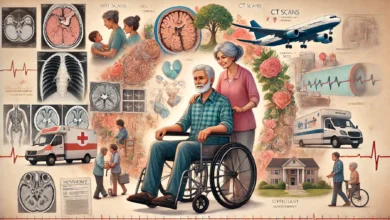It all started on Groundhog Day in 1977. It was my first year attending university in Michigan, my home state. I was personally recruited by the chairman of the piano performance department to come and study under him. I was 18, and everything was cool and exciting.
A car accident struck and upset every plan I had for my future. I woke up with spinal cord trauma at C5 and C6, resulting in quadriparesis and a concussion. It stands to reason that my ventral dural leak started at this point, with the resultant Superficial Siderosis (SS).
I went through months of occupational, physical, and speech therapies, but the headachesOverview It is challenging to pinpoint the exact cause of su... More became incapacitating soon after the accident. The pain and mobility challenges hampered everything I was used to doing: playing the piano, singing, walking straight, ice skating, skiing, martial arts, and more. The formal rehab for the acute injuries caused by the car accident returned me to a good, functional level and a starting point to feeling “normal.”

From music to OT
I returned to university the following September with an intense determination to succeed and a new major: occupational therapy. I chose OT because I felt that with my experiences I would be able to help other people facing similar challenges.
So, I transitioned from Bach, Beethoven, and Chopin to anatomy, kinesiology, and rehab coursework. After working in general rehab and home health, I went back for graduate work that specialized in hand and upper extremity therapy, which I practiced for most of my career, and attained the Certified Hand Therapist (CHT) designation.

The challenges of remaining physically fit
The headaches, which I now understand were spontaneous intracranial hypotensionOverview Craniospinal Hypotension, also known as Intracrania... More headaches (SIH), increased with moderate to significant physical exercise. Over the next 40 years (and four different states of residence), I sought help from multiple neurologists who all focused on the concussion aspect of my injury and simply labeled my headaches as general migraines or “post-exercise migraines” and just prescribed me medication, whether it was Darvocet, Cafergot, Zomig, or one of the many countless in-betweens. None of these worked effectively on a long-term basis.
During that same period, I worked to excel in an active lifestyle. The physical limitations I met due to the accident scared me, but also served as motivation. I snow skied and practiced martial arts, earning a black belt in Judo and rankings in JuJitsu. I also pursued teaching snow skiing professionally. Those sports in particular demanded a high level of balance: Unfortunately, mine was deteriorating to the point that I felt I was becoming a safety issue on the mat with my training partners, so the wisest thing I could do was to exit gracefully. For several years, I lived and ran at 6,000 ft elevation, but I paid a horrific toll: The headaches came from another planet! I conscientiously adjusted my workouts for frequency, intensity, and type regularly.

Now I garden and landscape our property. I have to pace myself when I dig out a new hole or transplant something; it’s heavier versus lighter work. I can’t start my regular chainsaw anymore, so I gave it up for a small battery-powered version. I can still cut up fallen trees for firewood and trim branches. I also still exercise daily in our basement/home gym, just not as intensely as before. The new mantra is: If it feels like it’s too much, it is! Lighten up and don’t push through the pain.

To be honest, I always had this premonition that there was something lurking, something physiologically wrong with me that was hanging over my head, and unfortunately now I know that my gut was right. I had this specific group and pattern of symptoms that just had to equate to a diagnosis or syndrome, somehow, but no doctor I saw could put it all together, or perhaps didn’t fully understand me. It’s always puzzled me that I was focused on being active to remain healthy (because there is no way I was going back to that wheelchair I had to use after the car accident), but why does it make me feel horrible when I exercise?
Facing hearing loss: cochlear implants and other assists
My hearing started to become more of an issue: Using my phone became nearly impossible, and my music appreciation was pretty much nil. I was on the Board of Directors of a regional music festival from about ’89 to ’93, but it became cumbersome to discuss music and perform the obligatory fundraising. While I described the amazing natural acoustics of the outdoor venue, I worried that I lacked credibility and it was creating some doubt in the minds of potential donors.
I started wearing hearing aids in 1992, but by the year 2000, my hearing had declined to the point of qualifying for a cochlear implant in my right ear. The otolaryngologist attempted to make a diagnosis, yet SS was not discussed at all. I was told that the implant was the only option, and while it did help me for about 3-5 years, its effectivity began to dwindle. My doctor and the manufacturer both labeled it a “soft failure” (the current thought is that this was precipitated by the SS progression). In 2017, I consented to a revision of the current implant as well as the installation of a new one in my left ear. As a result, I heard the stereo for the first time in decades. The performance has changed over the years, again, likely due to the continuous progression of SS, but it doesn’t negate the sense of gratitude I feel: It enabled me to work until retirement in environments with a variety of sounds, including clinical settings, teaching in seminars and workshops, academia, consults with medical supply manufacturers, and showcasing products and orthotic fabrication techniques at national conventions. It was nearly a decade between that revision surgery and the now accurate diagnosis of SS.
The Google app “Live Transcribe” has been an invaluable aid: It bridges the gap beautifully between what I can hear, lipread, and imagine what people are trying to tell me in real time.

Difficulties seeing and moving
Diplopia (double vision)Overview Diplopia, commonly known as double vision, happens ... More & nystagmusOverview Nystagmus involves the involuntary and uncontrolled... More (“bouncy” eyes) are ongoing problems for me. I empathize with bobblehead figurines! I need to wear bifocals, which can make it an additional challenge. I always strategize where I step, both on flat surfaces and uneven fields.
AtaxiaOverview Ataxia is considered a symptom of your superficial ... More and balance challenges have always been present to some degree, and it’s extremely frustrating. Just in the last two years, I’ve had to curtail and adapt many of my usual activities even more, including simply carrying a bucket of water to tend to some plants, or climbing a ladder to fill the bird feeders. I started using a cane in airports because people were making snide remarks about me being “drunk” while we were heading to our gate, even for the early morning flights. I now always use one when outside of our home. It seems to put people more at ease and give them a bona fide reason for my mobility issues… not just an ill-perceived drinking issue.
Coming to terms with the reality of my current situation and my future
I must admit, adjusting to and accepting the lifestyle changes has been tough, even though I’ve been gradually doing so for years. My original stint in rehab comes to mind, and I keep thinking, “I’ve done this already,” except this time, I’m not going to get better like I did before. It’s a constant challenge now, but I remind myself of what I learned the first time and how I can apply it to this situation.
Being an OT by profession has afforded me a unique perspective that I’m grateful for: I have a solid foundation in the principles of adaptation, and they come almost as a second nature to me at this point. A huge mental adjustment has been in having to do it for myself rather than for a patient in my professional role. My wife is also an OT, and after a collective century of service, we are both retired now. It makes for a good team because when I run out of ideas, she’s right there with a solution!
Admittedly, I can’t help but wonder how life would be now if the root cause had been identified when I first presented with symptoms.
SS has made a major impact on life. It’s taken 40+ years to get an accurate diagnosis of the condition and any solid plan of care. The pool of the CSF leak was from C2-T5 by the time it was identified, and that doesn’t happen quickly. Pain and stiffness are still there, and most likely always will be, but at least without the level of headaches I once had. I don’t have delusions of returning to the activity level of my younger self, but after all, I’m not 28 anymore: I’m 67 now. My goal is to be able to take longer walks with my wife and still be able to travel again.

The ventral dural leaks were patched in 2024 at multiple sites. I recently started on deferiprone, so now I have great hopes…even if some days really do feel like the movie Groundhog Day.
ADDENDUM:
While writing this, it occurred to me how many specialists I’ve pursued trying to find the answer. I’ll bet anyone reading this has a similar list…
Specialists seen: (* indicates multiple)
- Physiatrists*
- Neurologists*
- Orthopaedists*
- Neurosurgeons*
- Otolaryngologist*
- Physical Therapist*
- Audiologist*
- Interventional Radiologist
- Pain Management M.D.
- Neuro-ophthalmologist
- Ophthalmologists*
- Neuro Nurse Practitioner
Special studies:
- CAT scans of the head, neck, and ears*
- ENG (electronystagmography)*
- T2 MRIs of the head, c-spine, thoracic, and lumbar*
- Post rotary nystagmus
- DSM (digital subtraction myelography)*
- Dynamic myelogram
- EMG (electromyography)*
- Epidural blood patch
- SPECT (single photon emission computed tomography) scan



